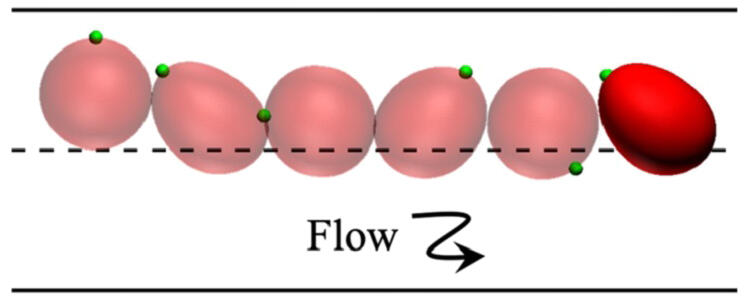Human blood vessels contain soft cells such as red blood cells, white blood cells, and platelets that flow due to the pulsation of the heart. While the behavior of rigid particles in steady flow fields has been well understood, it has been difficult to simultaneously track the deformation and position of soft particles within channels experimentally. Therefore, the physics of how soft particles like cells flow stably and where they position themselves within pulsatile flows in vessels was not previously understood.

Provided by Associate Professor Naoki Takeishi of Kyushu University
Associate Professor Naoki Takeishi from the Graduate School of Engineering, Kyushu University, in collaboration with Associate Professor Kenta Ishimoto from the Research Institute for Mathematical Sciences, Kyoto University, Professor Naoto Yokoyama from the School of Engineering, Tokyo Denki University, and Associate Professor Marco Edoardo Rosti from Okinawa Institute of Science and Technology Graduate University, has discovered through numerical simulation technology that soft particles (capsules consisting of internal fluid and membrane) flowing in pulsatile pipe flows converge to specific positions within the pipe cross-section depending on the pulsation frequency (period) and capsule deformation.
Furthermore, the research team reproduced the flow of capsules in pulsatile channel flows through numerical simulations and conducted large-scale numerical analysis on capsule behavior in relation to pulsation frequency and capsule membrane properties. Under relatively fast flow velocity conditions, they found that there exists a frequency at which capsules can continue to stably flow in a position away from the channel axis center. They discovered that this unique frequency appears universally even when the background flow velocity is increased.
Conversely, under slow flow velocity conditions, they found that capsules converge to the channel axis more quickly in certain frequency bands compared to steady flow. These results indicate that the behavior of soft particles in channels depends not only on the amount of deformation, which has been previously identified, but also on pulsation frequency. This means that controlling particle position in channels can be achieved by adjusting the frequency.
The team's findings are expected to be applied to new cell separation technologies and cellular diagnosis and drug screening technologies based on the concept of deformation control through pulsation frequency. Their research was published in the Journal of Fluid Mechanics.
Takeishi commented: "Through this research, we found that the behavior of soft particles in channels depends not only on the amount of deformation, as previously indicated, but also on pulsation frequency (period), and that control of particle position in channels can be achieved by adjusting that frequency. In the future, we aim to experimentally verify these findings obtained through numerical simulations and apply them as separation technologies for actual cell suspensions."
Journal Information
Publication: Journal of Fluid Mechanics
Title: Inertial focusing of spherical capsule in pulsatile channel flows
DOI: 10.1017/jfm.2025.184v
This article has been translated by JST with permission from The Science News Ltd. (https://sci-news.co.jp/). Unauthorized reproduction of the article and photographs is prohibited.




